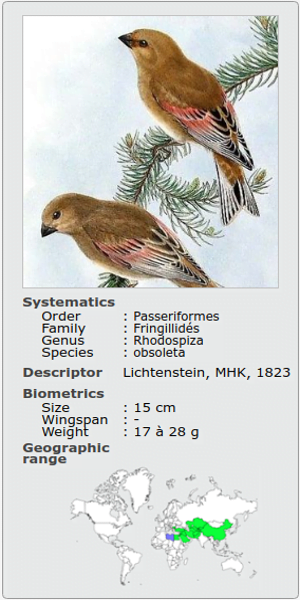INTRODUCTION:
The Common Rosefinch is a small, stocky Fringillidae usually common and widespread in Asia and Europe, breeding in the northern parts of the range and wintering southwards.
It frequents woodlands, thickets and forest edges near water in summer. During winter, it is mainly found in gardens and orchards, and also in damp and bushy meadows. This species nests in a loose, cup-shaped structure placed fairly low in vegetation or tree.
The Common Rosefinch is not globally threatened, but the population trend is suspected to be decreasing slowly. However, it is still common for now.


The Common Rosefinch adult male in breeding plumage has brown to dusky brown mantle, back, lesser coverts and scapulars, with paler edges to feathers. All are tinged red except in worn plumage.
The rump varies from pinkish-red to deep red, but it depends on the bird’s age, with some individuals showing brown-tipped feathers. The uppertail-coverts are brown with red tinge. The notched tail is brown with broad, paler to reddish-brown edges to outer rectrices.
On the upperwing, median and greater coverts are dark brown with paler edges and pale pink tips, forming a double wingbar. Alula, primary coverts and flight-feathers are dark brown with pale edges. Primaries and secondaries are tinged pale reddish-buff towards the tip.
On the underparts, chin, throat and breast centre are variably crimson. Breast sides and belly are buffish-white, sometimes slightly washed crimson. The flanks are tinged buffish-brown or sometimes washed with red. Undertail-coverts and thighs are whitish to buffish-white.
On the head, forehead to crown, nape and hindneck are bright red, often variable in extent and with brown bases to feathers. The lores are ashy-brown. Cheeks and ear-coverts are more or less dark brown, with variable crimson wash.
The fairly stout bill is greyish to dark grey-brown, but some adults may show pale yellowish-brown or pinkish base of lower mandible. The eyes are dark brown. Legs and feet are brown to pinkish-brown.
The adult male in winter has much duller plumage, including on the head.


The adult female is duller, with dull grey-brown plumage. Both upperparts and underparts are slightly dark-streaked. There are two weak pale wingbars.
On the plain, pale olive-brown head, forehead and crown show fine blackish streaks. The face is slightly paler. We can see a short, whitish-buff supercilium and a sub-ocular crescent. A broad, pale buff moustachial stripe is bordered by a darker malar stripe. The bare parts are similar to male.
The juvenile resembles adult female, but with brighter plumage overall. The wingbars are more conspicuous, like the pale tips to tertials, and the streaking is heavier.
The full adult plumage of males is not complete until the autumn or even later.
Both first summer and second summer males are like the adult female.

SUBSPECIES AND RANGE:
The Common Rosefinch has five subspecies that differ mainly in intensity and extend of red on head, upperparts and underparts, but in non-breeding plumage, these differences are less conspicuous.





























































































































































































































































































































































